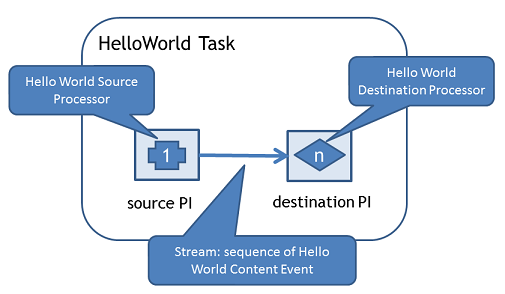A task is a machine learning related activity such as a specific evaluation for a classifier. For instance the prequential evaluation task is a task that uses each instance first for testing and then for training a model built using a specific classification algorithm. A task corresponds to a topology in SAMOA.
In this tutorial, we will develop a simple Hello World task.
Hello World Task
The Hello World task consists of a source processor, a destination processor with a parallelism hint setting, and a stream that connects the two. The source processor will generate a random integer which will be sent to the destination processor. The figure below shows the layout of Hello World task.

To develop the task, we create a new class that implements the interface org.apache.samoa.tasks.Task. For convenience we also implement com.github.javacliparser.Configurable which allows to parse command-line options.
The init method builds the topology by instantiating the necessary Processors, Streams and connecting the source processor with the destination processor.
Hello World Source Processor
We need a source processor which is an instance of EntranceProcessor to start a task in SAMOA. In this tutorial, the source processor is HelloWorldSourceProcessor.
The SAMOA runtime invokes the nextEvent method of EntranceProcessor until its hasNext method returns false. Each call to nextEvent should return the next ContentEvent to be sent to the topology. In this tutorial, HelloWorldSourceProcessor sends events of type HelloWorldContentEvent.
Here is the relevant code in HelloWorldSourceProcessor:
private Random rnd;
private final long maxInst;
private long count;
@Override
public boolean hasNext() {
return count < maxInst;
}
@Override
public ContentEvent nextEvent() {
count++;
return new HelloWorldContentEvent(rnd.nextInt(), false);
}
We also need to create a new type of ContentEvent to hold our data. In this tutorial we call it HelloWorldContentEvent and its content is simply an integer.
public class HelloWorldContentEvent implements ContentEvent {
private static final long serialVersionUID = -2406968925730298156L;
private final boolean isLastEvent;
private final int helloWorldData;
public HelloWorldContentEvent(int helloWorldData, boolean isLastEvent) {
this.isLastEvent = isLastEvent;
this.helloWorldData = helloWorldData;
}
@Override
public String getKey() {
return null;
}
@Override
public void setKey(String str) {
// do nothing, it's key-less content event
}
@Override
public boolean isLastEvent() {
return isLastEvent;
}
public int getHelloWorldData() {
return helloWorldData;
}
@Override
public String toString() {
return "HelloWorldContentEvent [helloWorldData=" + helloWorldData + "]";
}
}
Hello World Destination Processor
The destination processor for SAMOA is pretty straightforward and it will print the data from the event.
public class HelloWorldDestinationProcessor implements Processor {
private static final long serialVersionUID = -6042613438148776446L;
private int processorId;
@Override
public boolean process(ContentEvent event) {
System.out.println(processorId + ": " + event);
return true;
}
@Override
public void onCreate(int id) {
this.processorId = id;
}
@Override
public Processor newProcessor(Processor p) {
return new HelloWorldDestinationProcessor();
}
}
Putting It All Together
To put all the components together, we need to go back to class HelloWorldTask. First, we need to implement the code for setting up the TopologyBuilder. This code is necessary to be able to run on multiple platforms.
@Override
public void setFactory(ComponentFactory factory) {
builder = new TopologyBuilder(factory);
logger.debug("Sucessfully instantiating TopologyBuilder");
builder.initTopology(evaluationNameOption.getValue());
logger.debug("Sucessfully initializing SAMOA topology with name {}", evaluationNameOption.getValue());
}
After this method is called we have a functioning builder to get components for our topology. Next, the init method is called by SAMOA to start the task.
First we instantiate the source EntranceProcessor.
After adding the entrance processor to the topology, we create a stream originating from it. We use the create stream method of TopologyBuilder.
Next we create the destination processor and connect it to the stream by using shuffle grouping.
Once we have created all the components, we use the builder to build the topology.
@Override
public void init() {
// create source EntranceProcesor
sourceProcessor = new HelloWorldSourceProcessor(instanceLimitOption.getValue());
builder.addEntranceProcessor(sourceProcessor);
// create Stream
Stream stream = builder.createStream(sourceProcessor);
// create destination Processor
destProcessor = new HelloWorldDestinationProcessor();
builder.addProcessor(destProcessor, helloWorldParallelismOption.getValue());
builder.connectInputShuffleStream(stream, destProcessor);
// build the topology
helloWorldTopology = builder.build();
logger.debug("Successfully built the topology");
}
Running It
To run the example in local mode:
bin/samoa local target/SAMOA-Local-0.0.1-SNAPSHOT.jar "org.apache.samoa.examples.HelloWorldTask -p 4 -i 100"
To run the example in Storm local mode:
java -cp $STORM_HOME/lib/*:$STORM_HOME/storm-0.8.2.jar:target/SAMOA-Storm-0.0.1-SNAPSHOT.jar org.apache.samoa.LocalStormDoTask "org.apache.samoa.examples.HelloWorldTask -p 4 -i 1000"
All the code for the HelloWorldTask and its components can be found here.